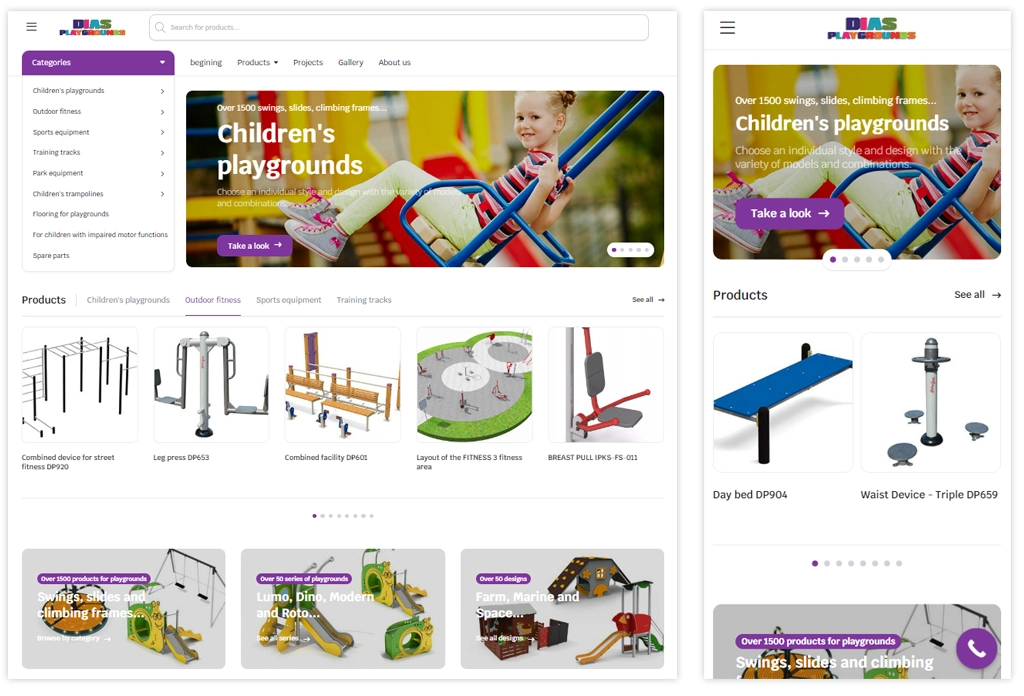What can go wrong when redesigning a working site and adding new projects, and how do we solve such problems at MOXX Advertising?
We took on the Dias Playgrounds website after the owner noticed that the theme was outdated, causing the site to become sluggish. Our task was to refresh all the content and add the product range from two new suppliers. The site was built on the WordPress CMS and featured around 300 products, including playground equipment, outdoor fitness and cardio machines, sports arenas, and more. The company also offered installation services and designed similar facilities nationwide, primarily catering to schools, kindergartens, and institutions building such playgrounds in public parks.
Project goals and objectives
After thorough discussions and SEO analyses, we identified the following goals and objectives:
- Redesign the website
- Technical optimisation
- Update and add new products
- SEO of content
Execution process
We divided the execution into several directions with corresponding subtasks and checks to address practice-established problematic points:
Analysis of existing information
For such projects, we create a comprehensive schema of current categories, examine relationships, download the existing sitemap for verification, and track accumulated information about the site in Google Search Console and Ahrefs.
Redesign of the website
We presented several themes that we customised to meet the client’s requirements. The website redesign involved changing categories, expanding menus, restructuring, and introducing new internal categories. After theme approval and the necessary changes, we initiated a comprehensive redesign and updated the dev server. Our designers prepared new banners, photos, and videos to enhance the visual appeal.
Adding new products
To add the new products, we wrote a script to scrape and gather information from the websites of the new suppliers. This was necessary because they did not provide an API or XML file. The script scraped images, meta data, titles, and all available information. The new products, along with the updated existing ones, were uploaded using the Product Import Export for WooCommerce module.
Content optimisation
Colleagues reviewed and rewrote the gathered information as needed. We updated all existing products, wrote and refreshed the blog section, added new images, banners, and videos to the gallery, rewrote and updated category texts, and implemented a filter and search functionality on the site. Products were categorised by design, series, purpose, and age groups.
We installed Rank Math SEO, WP Rocket, Smush, ImageMagick, and Schema Pro modules. Additionally, we utilised the Cloudflare CDN for the site.
Verification of changes
In projects like these, we perform content verification first by comparing the new and old sitemap files and secondly through Ahrefs.
The most common errors encountered include:
- Confused link names
kategoria > categoria > kategory
produkt > product
- Changes in paths for old products.
- Incorrect paths for new products.
- Incorrect category names.
During the Ahrefs check, approximately 29,000 warnings were identified.
The review revealed issues such as excessive link generation from the theme, duplicated content, and missing meta data. The first type of errors is challenging to catch without Ahrefs testing, while the second type is more likely due to oversight.
We removed unnecessary functions from the theme, optimised CSS and JavaScript files, and implemented additional corrections from the client.
Going live
The website passed the retests, and the updated information was transferred to the live domain. We added new sitemap files, categorised into product, category, blog, and other sitemaps in Google Search Console. We created an Analytics profile, set up tracking, and established supporting profiles on Facebook and LinkedIn. The site was submitted for updating on Google.
Conclusion and subsequent tasks
In similar redesigns, we adhere to mandatory client approval steps and conduct checks with at least two tools to avoid pitfalls from the theme and oversights from programmers and copywriters. We rely on time-tested practices, modules, and effective optimisation methods.
Satisfied with the execution, the client entrusted us with periodic technical support, approved the link-building strategy for the next 6 months, and committed to writing at least 2 articles for the internal blog in the next 12 months.
Planned activities include launching Google Ads, email marketing, and social media advertising.






Usually I do not read article on blogs however I would like to say that this writeup very compelled me to take a look at and do it Your writing style has been amazed me Thank you very nice article
Hey there You have done a fantastic job I will certainly digg it and personally recommend to my friends Im confident theyll be benefited from this site